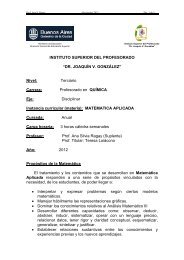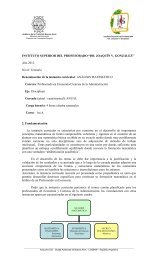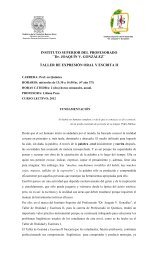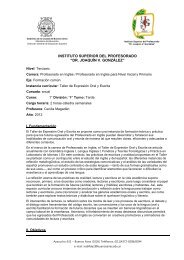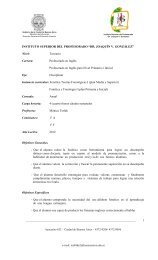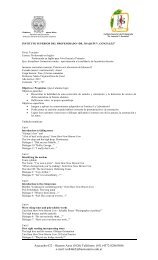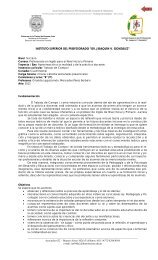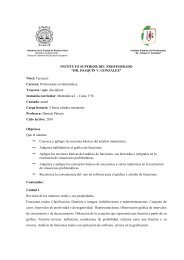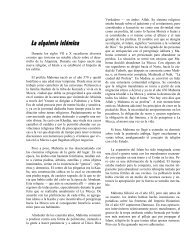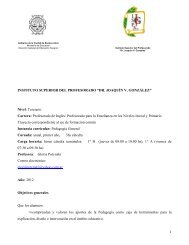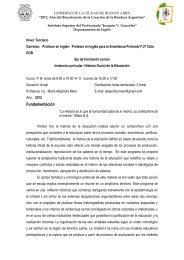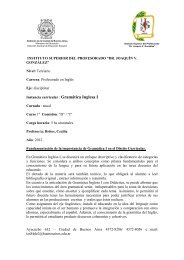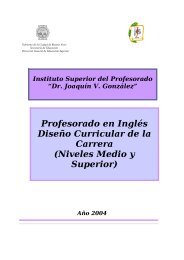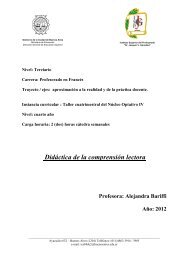vivieron una disyuntiva <strong>en</strong> los años cincu<strong>en</strong>ta <strong>de</strong>l <strong>siglo</strong> pasado, cuando tuvieronque <strong>de</strong>cidir <strong>en</strong>tre darle a <strong>el</strong><strong>la</strong> y a sus hermanos una educación tradicional(como campesinos) o <strong>en</strong>viarlos a <strong>la</strong> escue<strong>la</strong> primaria e int<strong>en</strong>tar que recibieranuna educación formal con carreras profesionales. Esto provocó cambios profundos<strong>en</strong> <strong>la</strong> transmisión <strong>de</strong>l patrimonio cultural, alterando <strong>el</strong> empleo <strong>de</strong> <strong>la</strong>l<strong>en</strong>gua indíg<strong>en</strong>a, <strong>el</strong> vestido y <strong>la</strong> ocupación.In the Maya indig<strong>en</strong>ous communities in Mexican State of Campeche, the familyhas be<strong>en</strong> a space of transmission of cultural expressions that are part of thecultural patrimony of this ethnic group. Within the range of expressions of theculture that this institution can s<strong>el</strong>ect to be transmitted in time and space, importantchanges have occurred in the <strong>la</strong>st c<strong>en</strong>tury. The paper <strong>de</strong>lves into theabove to discuss an interview with a woman, daughter of the Maya peasants,of the community of Calkiní. The story shows how the institutional educationwas gaining space on the family, as the dominant institution in the transmissionof knowledge and values. Appar<strong>en</strong>tly the par<strong>en</strong>ts of this woman lived adilemma in the fifties of the <strong>la</strong>st c<strong>en</strong>tury, wh<strong>en</strong> they had to <strong>de</strong>ci<strong>de</strong> betwe<strong>en</strong> giveher and her brother a traditional education (such as peasant) or s<strong>en</strong>d them tothe <strong>el</strong>em<strong>en</strong>tary school and attempt to receive a formal education. This led toprofound changes of the cultural patrimony, by altering the use of indig<strong>en</strong>ous<strong>la</strong>nguage, clothing and occupation.FLOOR QUADRADO, BeatrizGuaraní Club: memorias <strong>de</strong> una parte <strong>de</strong> <strong>la</strong> resist<strong>en</strong>ciaEste trabajo es una pres<strong>en</strong>tación <strong>de</strong> una investigación que se c<strong>en</strong>tra <strong>en</strong> <strong>la</strong> reconstrucción<strong>de</strong> <strong>la</strong> <strong>historia</strong> <strong>de</strong> un colegio <strong>de</strong> negro <strong>en</strong> <strong>el</strong> municipio <strong>de</strong> ArroioGran<strong>de</strong>, <strong>el</strong> “Club Guaraní”, más específicam<strong>en</strong>te sobre los motivos que llevarona su prohibición. La perspectiva es discutir <strong>la</strong> re<strong>la</strong>ción <strong>en</strong>tre <strong>la</strong> discriminacióny <strong>la</strong> lucha por <strong>la</strong> libertad, a través <strong>de</strong> recuerdos <strong>de</strong> búsqueda por <strong>la</strong>s aguassubterráneas, se utiliza <strong>el</strong> método <strong>de</strong> Historia Oral.This paper is a pres<strong>en</strong>tation of research that focuses on the reconstruction ofthe story of a b<strong>la</strong>ck college in the town of Arroio Gran<strong>de</strong>, the “Club Guaraní”,more specifically on the reasons that led to its prohibition. The perspective isto discuss the re<strong>la</strong>tionship betwe<strong>en</strong> discrimination and the fight for freedom,through memories of searching for groundwater using the method of <strong>oral</strong> history.SANTIAGO GUERRERO, Leticia Bibiana y BAXIN MELGOZA, ConcepciónLa pob<strong>la</strong>ción <strong>de</strong> Cadacamán <strong>en</strong>torno a <strong>la</strong> ex-misión<strong>de</strong> Santa Gertrudis <strong>la</strong> Magna: economía, cocina tradicionaly festividad, Ens<strong>en</strong>ada, Baja California, segundamitad <strong>de</strong>l Siglo XXEn <strong>la</strong> pob<strong>la</strong>ción originaria <strong>de</strong> Cadacamán, situada <strong>en</strong> <strong>la</strong> antigua jurisdicción <strong>de</strong><strong>la</strong> misión <strong>de</strong> Santa Gertrudis <strong>la</strong> Magna, ubicada <strong>en</strong> <strong>el</strong> sur <strong>de</strong>l municipio Ens<strong>en</strong>ada,Baja California, México, se c<strong>el</strong>ebra <strong>la</strong> festividad <strong>de</strong> Santa Gertrudis, <strong>la</strong> másantigua <strong>de</strong>l estado. Esta c<strong>el</strong>ebración reúne a los nativos que viv<strong>en</strong> dispersos<strong>en</strong> rancherías, <strong>en</strong> <strong>el</strong> área rural. La fiesta dura 3 días seguidos y se lleva a caboa mediados <strong>de</strong>l mes <strong>de</strong> noviembre <strong>de</strong> cada año. Este trabajo recoge <strong>la</strong> investigaciónrealizada <strong>en</strong> <strong>la</strong> ceremonia, como sabemos <strong>en</strong> <strong>la</strong> fiesta se <strong>en</strong>tretej<strong>en</strong> <strong>la</strong>sinstituciones económicas, r<strong>el</strong>igiosas, sociales y culturales que guían al grupoétnico.En <strong>el</strong> niv<strong>el</strong> metodológico se trabajó con Historia <strong>oral</strong>, tradición <strong>oral</strong>, análisis <strong>de</strong><strong>la</strong> imag<strong>en</strong>, (registro <strong>de</strong> fotografía y vi<strong>de</strong>o) y observación participante. En dichotrabajo <strong>de</strong> campo se recopi<strong>la</strong>ron activida<strong>de</strong>s, prácticas sociales y repres<strong>en</strong>taciones<strong>de</strong> los nativos <strong>en</strong> torno a <strong>la</strong> oferta <strong>de</strong> sus productos <strong>en</strong> <strong>la</strong> festividad asícomo a sus recetas tradicionales y <strong>de</strong>más refer<strong>en</strong>tes regionales <strong>de</strong> su c<strong>el</strong>ebración<strong>de</strong>vota.SALAZAR PEÑALOZA, Alejandro E.La <strong>oral</strong>idad <strong>en</strong> los Pueblos Originarios: reconocimi<strong>en</strong>toy práctica <strong>en</strong> <strong>la</strong> educaciónLa llegada <strong>de</strong> los exploradores europeos a América, a fines <strong>de</strong>l <strong>siglo</strong> XV, dioinicio a un nuevo y dramático proceso histórico, tanto para los primeros habitantes<strong>de</strong>l contin<strong>en</strong>te americano como para los recién llegados.El pres<strong>en</strong>te trabajo pret<strong>en</strong><strong>de</strong> dilucidar <strong>la</strong> pres<strong>en</strong>cia <strong>de</strong> los Pueblos Originarios<strong>en</strong> <strong>la</strong> historiografía arg<strong>en</strong>tina y <strong>la</strong> repres<strong>en</strong>tación social e histórica que <strong>de</strong> <strong>el</strong>losconstruyeron difer<strong>en</strong>tes <strong>historia</strong>dores <strong>de</strong> nuestro país. De esta manera creemosestar contribuy<strong>en</strong>do a <strong>la</strong> redacción <strong>de</strong> una nueva <strong>historia</strong>, con <strong>la</strong>s voces <strong>de</strong>actores olvidados, <strong>de</strong> forma int<strong>en</strong>cional y viol<strong>en</strong>ta, y así g<strong>en</strong>erar una <strong>historia</strong>don<strong>de</strong> todos estemos incluidos, don<strong>de</strong> todos seamos conocedores <strong>de</strong> nuestropasado, constructores <strong>de</strong>l pres<strong>en</strong>te y soñadores <strong>de</strong> un futuro mejor, tomandoasí a <strong>la</strong> educación como eje c<strong>en</strong>tral <strong>de</strong>l proceso.The arrival of European explorers to America in the <strong>la</strong>te fifte<strong>en</strong>th c<strong>en</strong>tury, begana dramatic new historical process, both for the first inhabitants of theAmericas and for the newcomers.This wok int<strong>en</strong>ds <strong>el</strong>ucidate the pres<strong>en</strong>ce of Indig<strong>en</strong>ous Peoples in Arg<strong>en</strong>tinahistoriography and social and historical repres<strong>en</strong>tation of them built differ<strong>en</strong>t<strong>historia</strong>ns of our country. In this way we b<strong>el</strong>ieve we are contributing to the draftingof a new history, with the voices of forgott<strong>en</strong> actors, with int<strong>en</strong>t and viol<strong>en</strong>t,and g<strong>en</strong>erate a history where all of us including where we are all familiarwith our past, pres<strong>en</strong>t and dreamers buil<strong>de</strong>rs for a better future, aking w<strong>el</strong>l toeducation as the c<strong>en</strong>tral axis of the process.Hoppe, SigridDevoción a San Cristóbal <strong>en</strong> <strong>la</strong> Colonia Juliano MoreiraIn this paper we are trying to un<strong>de</strong>rstand the singu<strong>la</strong>rity of the manifestationsof <strong>de</strong>votion to St. Christopher in the hospital Colony Juliano Moreira (CJM);manifestations that make sure that this tradition continues to be conveyed formore than 50 years, while the other catholic <strong>de</strong>votional manifestations consi<strong>de</strong>redto be important in the rec<strong>en</strong>t past of this p<strong>la</strong>ce have become mo<strong>de</strong>st orobsolete. Foun<strong>de</strong>d in 1924, on a p<strong>la</strong>ntation disappropriated by the Brazilian Fe<strong>de</strong>ralGovernm<strong>en</strong>t, the hospital Colony Juliano Moreira was macro-hospital forchronic m<strong>en</strong>tal illnesses. The day-to-day living together betwe<strong>en</strong> the pati<strong>en</strong>tsand the families was one of the gui<strong>de</strong>lines of the hospital treatm<strong>en</strong>t and theColony turned into a p<strong>la</strong>ce with a lot of differ<strong>en</strong>t services such as: commerce, aschool, a cinema, a club. In the <strong>de</strong>ca<strong>de</strong>s of 1970 and 1980, the CJM un<strong>de</strong>rw<strong>en</strong>ta process of progressive <strong>de</strong>cay, in which the number of pati<strong>en</strong>ts and professionalswas reduced and the instal<strong>la</strong>tions, the services and tra<strong>de</strong> became verypoor and <strong>de</strong>fici<strong>en</strong>t. With the anti-m<strong>en</strong>tal hospital movem<strong>en</strong>t, the national forum,ma<strong>de</strong> up of various <strong>en</strong>tities, such as NGOs and Councils of the m<strong>en</strong>tallyill re<strong>la</strong>tives, a lot of hospitalized pati<strong>en</strong>ts w<strong>en</strong>t back to live with their familieswhile others w<strong>en</strong>t to therapeutic resi<strong>de</strong>nces and few were left in the halls ofthe hospital. Over the <strong>la</strong>st couple of years, this p<strong>la</strong>ce has be<strong>en</strong> attracting newresi<strong>de</strong>nts. Besi<strong>de</strong>s the fact that so many changes occurred in the activities ofthe hospital complex and the day-to-day life of the resi<strong>de</strong>nts of these premises,the drivers and mechanics of the hospital still continue r<strong>el</strong>evant maintainingthe tradition in a tribute of its patron Saint every July 25th.——————————————————————————————————————————————13.15 a 14.45 - Almuerzo——————————————————————————————————————————————In the original popu<strong>la</strong>tion of Cadacamán, located in the former jurisdiction ofthe mission of St. Gertru<strong>de</strong> the Great, located in the south of the town Ens<strong>en</strong>ada,Baja California, Mexico, the feast of St. Gertru<strong>de</strong>, the ol<strong>de</strong>st in the state, ish<strong>el</strong>d. This c<strong>el</strong>ebration brings together the natives who live scattered in vil<strong>la</strong>gesin rural areas. The festival <strong>la</strong>sts for 3 consecutive days and is h<strong>el</strong>d in mid Novembereach year. This work inclu<strong>de</strong>s research into the ceremony; as we know,the c<strong>el</strong>ebration interweaves the economic, r<strong>el</strong>igious, social and cultural factorsthat gui<strong>de</strong> these ethnic groups.At the methodological lev<strong>el</strong>, we worked with <strong>oral</strong> history, <strong>oral</strong> tradition,image analysis, (photo and vi<strong>de</strong>o registry) and participant observation. Asfi<strong>el</strong>d work, social practices, activities and repres<strong>en</strong>tations of the natives regardingthe products offered at the festival, as w<strong>el</strong>l as their traditional recipesand other regional refer<strong>en</strong>ces involving their <strong>de</strong>voted c<strong>el</strong>ebration werecollected.36
14.45 a 16.45 horasC<strong>en</strong>tro Cultural G<strong>en</strong>eral San Martín——————————————————————————————————————————————Subtema / Subteme 1Patrimonio, museos e <strong>historia</strong> <strong>oral</strong> / Heritage,museums and Oral History1.1 Archivos y lugares <strong>de</strong> <strong>la</strong> memoria / Archives andp<strong>la</strong>ces of memorySa<strong>la</strong> C - Mesa / Session 4 - Lugares <strong>de</strong> <strong>la</strong> memoria eHistoria OralCoordinan / Chair: Liliana Bare<strong>la</strong> y María Inés Rodríguez——————————————————————————————————————————————MORAES GARCIA LIMA, LiviaHistoria Oral y Patrimonio Cultural: El contexto <strong>de</strong><strong>la</strong>s haci<strong>en</strong>das históricas <strong>en</strong> <strong>el</strong> Estado <strong>de</strong> Sao Paulo(Brasil)La int<strong>en</strong>ción principal <strong>de</strong> este estudio es analizar <strong>la</strong>s acciones <strong>de</strong> educaciónpatrimonial no formal realizadas <strong>en</strong> <strong>el</strong> ámbito <strong>de</strong>l medio rural paulista, <strong>en</strong>focadaa difer<strong>en</strong>tes grupos etarios, <strong>de</strong> difer<strong>en</strong>tes c<strong>la</strong>ses sociales, a partir <strong>de</strong> <strong>la</strong>comparación <strong>de</strong> tres haci<strong>en</strong>das históricas Paulistas, s<strong>el</strong>eccionadas <strong>en</strong>tre <strong>la</strong>sque participan <strong>de</strong>l proyecto PPPP/FAPESP (07/55999-1). En <strong>el</strong> estudio anterior<strong>de</strong> Magister fueron <strong>de</strong>tectados tres tipos <strong>de</strong> Haci<strong>en</strong>das: 1° tipo- haci<strong>en</strong>das queofrec<strong>en</strong> activida<strong>de</strong>s turísticas <strong>en</strong> forma <strong>de</strong> visita diaria, 2° tipo- haci<strong>en</strong>das querealizan turismo y estadía o 3° tipo- haci<strong>en</strong>das que realizan turismo/ empresaa través <strong>de</strong> una haci<strong>en</strong>da- hot<strong>el</strong>. Para <strong>la</strong> realización <strong>de</strong> <strong>la</strong>s investigaciones quecontemp<strong>la</strong>n los objetivos <strong>de</strong> estudio, será realizado un amplio levantami<strong>en</strong>tobibliográfico sobre los temas <strong>de</strong> estudio. El alim<strong>en</strong>tará <strong>la</strong> guía para <strong>la</strong> realización<strong>de</strong> <strong>en</strong>trevistas con los tres responsables por <strong>la</strong>s propieda<strong>de</strong>s históricas s<strong>el</strong>eccionadas,con los funcionarios más antiguos, con los monitores y visitantes/turistas. Este proceso será realizado a partir <strong>de</strong> una metodología <strong>de</strong> caráctercualitativo (Historia Oral) con énfasis <strong>en</strong> dos técnicas: La <strong>en</strong>trevista abierta y<strong>el</strong> testimonio temático. En una segunda fase <strong>de</strong> <strong>la</strong> investigación, <strong>el</strong> cont<strong>en</strong>ido<strong>de</strong> <strong>la</strong>s <strong>en</strong>trevistas será organizado temáticam<strong>en</strong>te y analizado a <strong>la</strong> luz <strong>de</strong><strong>la</strong>s producciones mas reci<strong>en</strong>tes <strong>de</strong> educación patrimonial, comparando susresultados con aqu<strong>el</strong>los <strong>de</strong> análisis <strong>de</strong> <strong>la</strong> bibliografía específica, <strong>en</strong> <strong>el</strong> s<strong>en</strong>tido<strong>de</strong> producir instrum<strong>en</strong>tos para <strong>el</strong> análisis crítico <strong>de</strong> <strong>la</strong>s activida<strong>de</strong>s <strong>de</strong> turismocultural <strong>en</strong> <strong>el</strong> espacio rural <strong>de</strong> educación patrimonial observados.PLAZAS DIAZ, Leidy CarolinaEl molino Tundama: Símbolo <strong>de</strong>l <strong>de</strong>sarrollo fabril <strong>en</strong>Duitma- ColombiaLa pon<strong>en</strong>cia a pres<strong>en</strong>tar surge <strong>de</strong>l trabajo <strong>de</strong> investigación histórica sobre<strong>la</strong> consolidación <strong>de</strong> <strong>la</strong> primera fábrica instaurada <strong>en</strong> <strong>el</strong> municipio <strong>de</strong> Duitama,<strong>de</strong>partam<strong>en</strong>to <strong>de</strong> Boyacá- Colombia <strong>en</strong>tre 1911-1940, periodo <strong>en</strong> <strong>el</strong>que se <strong>de</strong>sarrol<strong>la</strong> <strong>la</strong> primera etapa <strong>de</strong> industrialización <strong>en</strong> <strong>el</strong> país. Con <strong>la</strong>construcción <strong>de</strong>l “Molino Tundama” se logra una transición <strong>en</strong> <strong>el</strong> sistema<strong>de</strong> producción <strong>de</strong> harina <strong>de</strong> trigo manual y comunitaria a una produccióntecnificada y con fines <strong>de</strong> comercialización <strong>de</strong> dicho producto, a<strong>de</strong>más <strong>de</strong>otra serie <strong>de</strong> cambios <strong>en</strong> <strong>la</strong>s activida<strong>de</strong>s económicas, <strong>de</strong>mográficas, sociales,y <strong>la</strong> importancia arquitectónica y simbólica <strong>de</strong> <strong>la</strong> edificación para loshabitantes <strong>de</strong>l municipio <strong>en</strong> aqu<strong>el</strong> mom<strong>en</strong>to. Otro <strong>el</strong>em<strong>en</strong>to importante<strong>de</strong>ntro <strong>de</strong> <strong>la</strong> investigación fue <strong>el</strong> análisis <strong>de</strong> <strong>la</strong>s políticas <strong>de</strong> importación <strong>de</strong>trigo y maquinarias, lo que causó afr<strong>en</strong>tas <strong>en</strong>tre los trabajadores triguerosy <strong>el</strong> gobierno, una <strong>de</strong>fici<strong>en</strong>te política <strong>de</strong> protección <strong>en</strong> <strong>la</strong> producción y <strong>la</strong>limitación que originó un incipi<strong>en</strong>te <strong>de</strong>sarrollo fabril a niv<strong>el</strong> local, regionaly nacional. El trabajo se <strong>de</strong>sarrolló con información primaria obt<strong>en</strong>ida <strong>en</strong><strong>la</strong> revisión <strong>de</strong> docum<strong>en</strong>tos <strong>en</strong> los archivos regionales y <strong>el</strong> archivo nacional,<strong>la</strong>s narraciones <strong>oral</strong>es <strong>de</strong> habitantes que trabajaron <strong>en</strong> <strong>la</strong> fábrica, otros qu<strong>el</strong>legaron al municipio atraídos por <strong>el</strong> paradigma <strong>de</strong> <strong>la</strong>s socieda<strong>de</strong>s urbanas,otros que t<strong>en</strong>ían algún archivo familiar y fotográfico <strong>de</strong>l municipio y especialm<strong>en</strong>te<strong>de</strong>l molino, y otras personas que han trabajado <strong>en</strong> <strong>la</strong> gestión yconservación <strong>de</strong>l lugar como patrimonio material, cultural e histórico <strong>de</strong>lmunicipio.El propósito <strong>de</strong>l trabajo es promover <strong>la</strong> importancia <strong>de</strong> <strong>la</strong> memoria históricay cultural para <strong>la</strong> i<strong>de</strong>ntidad <strong>de</strong> los habitantes <strong>de</strong> <strong>la</strong> región; <strong>el</strong> reconocimi<strong>en</strong>to<strong>de</strong>l <strong>la</strong> fábrica harinera como <strong>la</strong> pionera <strong>en</strong> <strong>el</strong> <strong>de</strong>sarrollo económico; <strong>el</strong> rescate<strong>de</strong> <strong>la</strong> <strong>la</strong>bor <strong>de</strong> aqu<strong>el</strong>los trabajadores que cim<strong>en</strong>taron <strong>la</strong>s bases <strong>de</strong>l <strong>de</strong>sarrollo<strong>en</strong> <strong>el</strong> municipio para llegar a ser hoy día c<strong>en</strong>tro fabril, comercial y cívico <strong>de</strong>l<strong>de</strong>partam<strong>en</strong>to, y <strong>la</strong> conservación <strong>de</strong> <strong>la</strong> edificación como patrimonio materialy cultural <strong>de</strong> Duitama.YÁÑEZ, Gracie<strong>la</strong> Beatriz y RINALDI, María Av<strong>el</strong>inaAportes para <strong>la</strong> construcción <strong>de</strong> memoria sobre <strong>la</strong>sestaciones <strong>de</strong> ferrocarril y <strong>el</strong> mercado <strong>en</strong> <strong>la</strong> ciudad <strong>de</strong>San LuisEn <strong>la</strong> ciudad <strong>de</strong> San Luis, dos lugares <strong>de</strong> <strong>la</strong> memoria: <strong>la</strong> Vieja Estación <strong>de</strong>l FerrocarrilAndino y <strong>el</strong> Mercado Municipal que se constituy<strong>en</strong> como puntos <strong>de</strong> refer<strong>en</strong>cia<strong>de</strong> varias g<strong>en</strong>eraciones, solo perduran <strong>en</strong> <strong>el</strong> recuerdo <strong>de</strong> los mayores <strong>de</strong>50 años, ya que han sido <strong>de</strong>molidos a fines <strong>de</strong> 1968, provocando los efectos <strong>de</strong>olvido <strong>en</strong> <strong>la</strong>s nuevas g<strong>en</strong>eraciones. La “Nueva” Estación <strong>de</strong> ferrocarril que aúnse conserva, lugar monum<strong>en</strong>tal por su arquitectura y ubicación, osci<strong>la</strong> <strong>en</strong>tremom<strong>en</strong>tos <strong>de</strong> valoración y abandono. La abrupta <strong>de</strong>saparición <strong>de</strong> su funciónoriginal y <strong>el</strong> cambio <strong>de</strong> uso provocaron un fuerte cambio <strong>de</strong> s<strong>en</strong>tido <strong>en</strong>tre niñosy jóv<strong>en</strong>es.Des<strong>de</strong> <strong>el</strong> Proyecto <strong>de</strong> Investigación “Patrimonio Cultural y Didáctica” <strong>de</strong> <strong>la</strong>Universidad Nacional <strong>de</strong> San Luis, hemos construido conocimi<strong>en</strong>to acerca <strong>de</strong>estos lugares <strong>de</strong> <strong>la</strong> memoria utilizando <strong>la</strong>s herrami<strong>en</strong>tas <strong>de</strong> <strong>la</strong> Historia Oral, <strong>en</strong>un contexto <strong>de</strong> fuerte lucha por <strong>la</strong> memoria. En un segundo mom<strong>en</strong>to hemose<strong>la</strong>borado materiales que comunican dicho conocimi<strong>en</strong>to <strong>de</strong>s<strong>de</strong> <strong>la</strong> imag<strong>en</strong>,<strong>el</strong> testimonio y <strong>la</strong> interpretación teórica. Estos pret<strong>en</strong><strong>de</strong>n <strong>de</strong>volver su propiaimag<strong>en</strong> <strong>de</strong>l pasado a los vecinos <strong>de</strong> <strong>la</strong> ciudad y -como material didáctico esco<strong>la</strong>r-ti<strong>en</strong><strong>en</strong> <strong>el</strong> propósito <strong>de</strong> construir memoria acerca <strong>de</strong> estos lugares <strong>en</strong> <strong>la</strong>snuevas g<strong>en</strong>eraciones.En esta pon<strong>en</strong>cia queremos compartir <strong>el</strong> s<strong>en</strong>tido que para los vecinos ti<strong>en</strong><strong>en</strong>estos lugares <strong>de</strong> <strong>la</strong> memoria, su proceso <strong>de</strong> olvido y <strong>en</strong> particu<strong>la</strong>r dos materialesdidácticos (juego <strong>de</strong> recorrido y caja didáctica) como aporte para <strong>la</strong> reconstrucción<strong>de</strong> <strong>la</strong> memoria.HAVLŮJOVÁ, Gabrie<strong>la</strong>Lidice as a P<strong>la</strong>ce of Memories - Lidice Mem<strong>en</strong>toAuthor is, in her report, <strong>de</strong>aling with Lidice vil<strong>la</strong>ge, as if an object of memoryand reflection of not only post-war and contemporary Czech society. Assasinationon SS Obergrupp<strong>en</strong>führer Reinhard Heydrich affected the <strong>de</strong>stiny ofcitiz<strong>en</strong>s of this Czech vil<strong>la</strong>ge as w<strong>el</strong>l as following investigation. 173 m<strong>en</strong> wereshot to <strong>de</strong>ad on 10th of June 1942. Wom<strong>en</strong> were s<strong>en</strong>t to conc<strong>en</strong>tration campin Rav<strong>en</strong>sbrück, 105 childr<strong>en</strong> were s<strong>en</strong>t to Po<strong>la</strong>nd, where 82 of them were gasifiedin Ch<strong>el</strong>mno. Lidice vil<strong>la</strong>ge should be erased from the map and <strong>de</strong>stroyedcomplet<strong>el</strong>y.Lidice has become a part of collective as w<strong>el</strong>l as historical memory practicallyas soon as it was burned out. In context of Czech society no longer than afterthe <strong>en</strong>d of WW2. Equally, thanks to <strong>en</strong>ormous worldwi<strong>de</strong> press reception oftragedy in Lidice, Lidice has become a symbol that surpassed re<strong>la</strong>tiv<strong>el</strong>y lessm<strong>en</strong>tioned Jewish holocaust and complet<strong>el</strong>y neglected Romany holocaust.The greatest reception of tragedy in Lidice was noticed in Latin America, wherethe title Lidice was used to name newborn <strong>la</strong>dies and to r<strong>en</strong>ame vil<strong>la</strong>ges.In the run of preceding <strong>de</strong>ca<strong>de</strong>s, picture of Lidice and its reflection in Czechsociety w<strong>en</strong>t through series of changes. E.g. communist power created itsown symbol of this Czech vil<strong>la</strong>ge. Symbol of communist propaganda, symbolof battle against warfare, symbol of solidarity and connection with other peacefulforces etc. Rever<strong>en</strong>t p<strong>la</strong>ce, such as unique example of public p<strong>la</strong>ce hasbecome a p<strong>la</strong>ce, where communist power, particu<strong>la</strong>rly during rever<strong>en</strong>t memories,used people gathering to propagation of communism. Some authors ev<strong>en</strong>work with i<strong>de</strong>a that Lidice as a symbol of Nazi <strong>de</strong>spotism and viol<strong>en</strong>ce should,in Czech society, surpass holocaust reflection. Just this effort to change Lidiceinto communistic symbol lead Lidice almost to its oblivion after revolution in1989, because vil<strong>la</strong>ge that was pres<strong>en</strong>ted as communistic, f<strong>el</strong>l into politicalunconcern as w<strong>el</strong>l as bigger part of society.In my report, I g<strong>en</strong>erally want to <strong>de</strong>al with matters of memoirs on Lidice andLidice mem<strong>en</strong>to, that are matters, how do wom<strong>en</strong> and childr<strong>en</strong> survivors rememberLidice? What memoir do Lidice visitors cherish from communistic era?Do these memoirs mutually differ and are they in conflict?HENAO MAFLA, Samir Alexan<strong>de</strong>rEl lugar <strong>de</strong>l olvido <strong>en</strong> <strong>la</strong> <strong>historia</strong> <strong>de</strong> <strong>la</strong>s ciuda<strong>de</strong>s. Elcaso <strong>de</strong>l C<strong>en</strong>tro Histórico <strong>de</strong> Santiago <strong>de</strong> Cali (Colombia):1980 – 1999El C<strong>en</strong>tro Histórico <strong>de</strong> Santiago <strong>de</strong> Cali es un lugar <strong>de</strong> refer<strong>en</strong>cia fundam<strong>en</strong>talpara <strong>la</strong> conservación <strong>de</strong> <strong>la</strong> conci<strong>en</strong>cia histórica <strong>de</strong> esta ciudad, pero si esasí, ¿Por qué este espacio se constituye es un lugar <strong>de</strong> olvido <strong>en</strong> su <strong>historia</strong>reci<strong>en</strong>te? Compr<strong>en</strong><strong>de</strong>r <strong>el</strong> por que <strong>de</strong> su escaso s<strong>en</strong>tido <strong>de</strong> repres<strong>en</strong>tatividad.En ese s<strong>en</strong>tido, es necesario evi<strong>de</strong>nciar esta car<strong>en</strong>cia <strong>de</strong> historicidad como37



